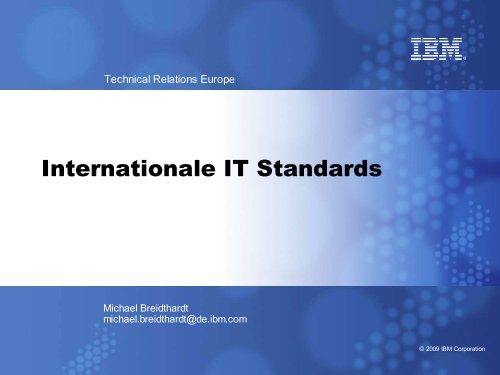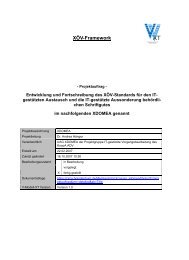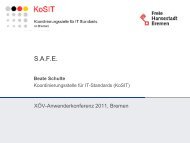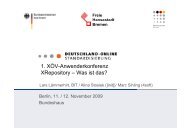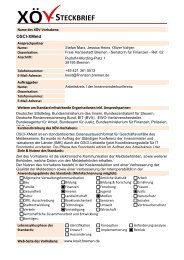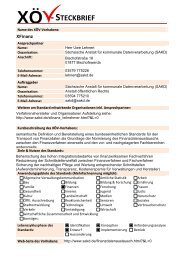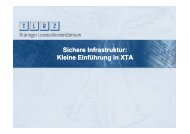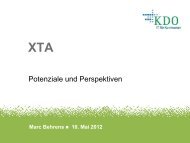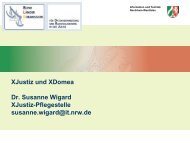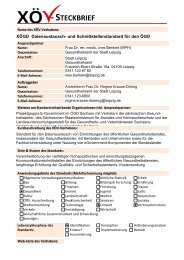Internationale IT-Standards (pdf, 813.5 KB) - XÖV
Internationale IT-Standards (pdf, 813.5 KB) - XÖV
Internationale IT-Standards (pdf, 813.5 KB) - XÖV
Erfolgreiche ePaper selbst erstellen
Machen Sie aus Ihren PDF Publikationen ein blätterbares Flipbook mit unserer einzigartigen Google optimierten e-Paper Software.
IBM Techechnicacal Relelatations EuropeWelche Arten von “<strong>Standards</strong>” gibt es ?de factoMicrosoft Office “.doc” FormatAdobe PDF (heute ISO Standard, begann aber als “de facto” Standard)Community basierendIETF, W3C, OASIS, UDDI, JCPde jureISO, ANSI, DIN, BSI,...ISO 9000 Quality Management,ISO/IEC 27000 Information Security Management System StandardISO/IEC 26300 Open Document FormatIBM ist in allen diesen Bereichen tätigIBM bevorzugt Community und de jure <strong>Standards</strong>Michael Breidthardt | michael.breidthardt@de.ibm.com3© 2009 IBM Corporation
IBM Techechnicacal Relelatations EuropeWarum sind <strong>Standards</strong> wichtig für unsereKunden und für die Industrie insgesamt?“Open standards must take hold in everyindustry. Without them, it's too difficultand costly to achieve the kind oftransformation we've been talking about. Iam not speaking just about technologystandards, either. <strong>Standards</strong> exist in everyindustry, whether they are documentformats, patient healthcare records,financial trading systems, securitydatabases or inventory control systems.”Sam Palmisano, IBM Business LeadershipForum, ParisOctober 8, 20044"Open standards are important to help createinteroperable and affordable solutions foreverybody. They also promote competition bysetting up a technical playing field that is level toall market players. This means lower costs forenterprises and, ultimately, the consumer.We need certain basic rules and regulations for theInformation Society to yield all its benefits and wehave to have a framework in place that protectsenterprises and citizens, that fosters innovation andthat avoids unnecessary technical barriers. Openstandards are an ideal way to support such aframework.”EU Commissioner Erkki LiikanenWorld <strong>Standards</strong> DayOctober 14, 2003October 14, 200Oct3Michael Breidthardt | michael.breidthardt@de.ibm.com4© 2009 IBM Corporation
IBM Techechnicacal Relelatations EuropeWas ist ein “Offener Standard”?Ein offener Standard wird vonunabhängigen Organisationenentwickelt und gepflegt, derenExperten aus verschiedenenbetroffenenen Kreisen kommenKein einzelner Hersteller ist in derLage den Standard zu 'diktieren',kann die Regeln so beeinflussen,dass der Standard mit seinenProdukten konform sein muss,oder dass nur er Implementierungendes <strong>Standards</strong> produzieren kann.Ein offener Standard ist frei verfügbar und von jedem implementierbar.Das schliesst Open Source Implementierungen ein, wenn essich um Software Interoperabilty <strong>Standards</strong> handelt. .Michael Breidthardt | michael.breidthardt@de.ibm.com© 2009 IBM Corporation
IBM Techechnicacal Relelatations EuropeIBM Bekenntnis zu Open <strong>Standards</strong>■IBM's <strong>Standards</strong> Prinzipien 1) sind ein Bekenntnis zu offenen <strong>Standards</strong> undfairen und korrekten <strong>Standards</strong>entwicklungs-Prozessen und - Regeln.■IBM ist Mitglied in vielen ausgezeichneten Standardisierungs-Organisationenund beabsichtigt, die gute und produktive Zusammenarbeit mit diesenfortzuführen.■IBM wird sich Standardisierungs-Organisationen im Hinblick auf Offenheit undTransparenz der Prozesse und zeitgemässer Patent-Regeln genauerbetrachten.■IBM hofft, dass wir mit unserer Erfahrung helfen können, jegliche Probleme, diedabei gefunden werden, in vertrauensvoller und konstruktiver Weise zu lösen.1) die IBM <strong>Standards</strong> Prinizipien wurden im September 2008 angekündigtMichael Breidthardt | michael.breidthardt@de.ibm.com11/10/09 6© 2009 IBM Corporation
IBM Techechnicacal Relelatations EuropeIBM <strong>Standards</strong> Principles Process Quality: Begin or end participation in standards bodies based on the qualityand openness of their processes, membership rules, and intellectual property policies. Global Applicatition: Encourage emerging and developed economies to both adopt openglobal standards and to participate in the creation of those standards. Participant Independence: Advance governance rules within standards bodies thatensure technology decisions, votes, and dispute resolutions are made fairly byindependent participants, protected from undue influence. Implementatabilityty: Collaborate with standards bodies and developer communities toensure that open software interoperability standards are freely available andimplementable. Bettetter IPRPolicies: Help drive the creation of clear, simple and consistent intellectualproperty policies for standards organizations, thereby enabling standards developers andimplementers to make informed technical and business decisions.Michael Breidthardt | michael.breidthardt@de.ibm.com11/10/09 7© 2009 IBM Corporation
IBM Techechnicacal Relelatations EuropeWelchen Effekt haben Offene <strong>Standards</strong> ... sie begünstigen Software Interoperabilität und Austauschbarkeit. ... sie durchbrechen traditionelle Abhängigkeiten(Proprietäre Methoden, Vendor lock-in, etc.) ... sie sind das Fundament auf dem Andereaufbauen und Innovationen entwickeln können ... sie schaffen ein Marktausgleich, dereinen verstärkten Wettbewerb für neueMarktteilnehmer und für neue Ideen ermöglicht .. sie sind eine Gefahr für alle, die fürchten,dass ihre marktbeherrschenden ErfolgsprodukteAnteile im verstärkten Wettbewerb verlieren Dies erzeugt Widerstand, wenn auch manchmalnicht offen ausgetragenMichael Breidthardt | michael.breidthardt@de.ibm.com© 2009 IBM Corporation
IBM Techechnicacal Relelatations EuropeSoftware InteroperabilityInterface <strong>Standards</strong>SoftwareInteroperabilitySoftwareInterfaceStds..ApplicationsInfrastructureOperatingEnvironmentHardwareApplicationsInfrastructureOperatingEnvironmentHardwareSoftwareInterfaceStds.Software Interoperability Interface Standard:Daten-Formate, Protokolle, Programmier-Schnittstellen undSchnittstellen-Beschreibungs-Sprachen, die dazu bestimmt sind,von zwei verschiedenen Programmen angewandt zu werden, umbei der Zusammenarbeit die volle Funktionalität beider Programmesicherstellen zu können.Michael Breidthardt | michael.breidthardt@de.ibm.com© 2009 IBM Corporation11/10/09 9 Template Documentation
W 3 CO A S I SOth thers...I E T FI E E EO G FOthth thers...Sm Small, mostltly “private” foraand consortiaIBM Techechnicacal Relelatations EuropeGlobal <strong>Standards</strong> Ecosystem in the ICT DomainIECWorld <strong>Standards</strong> Cooperation (WSC)ISO ISOJ T C 1<strong>IT</strong>UCENELELECEC CENCENCEN/CENELEC ICT ForumI C T S BETSIJEIAJISJISTTCANSI-USNCANSI INC<strong>IT</strong>SUSNC-TSUTEAFNORCFETSICEIDKEUNIDINGIETS<strong>IT</strong>BETSIBSIBSIDTIFORMAL STANDARDISATIONDIRECT PARTICIPATION10Michael Breidthardt | michael.breidthardt@de.ibm.com© 2009 IBM Corporation
IBM Techechnicacal Relelatations EuropeCollaborating to Create Open <strong>Standards</strong>NeededInitiatorCore group<strong>Standards</strong> bodyOpenCustomer need fortechnical solution to aknown problemLack of industryaccepted technicalsolutionMay be competingtechnical approachesor single proprietarysolutionLack of interoperabilityA company, individualor group of companiesor individuals agree toaddress issueResources devoted todeveloping besttechnical solution, oftenin collaborative fashionInterested parties publishspecificationsSpecifications publiclyavailable and sufficient toenable implementation,interoperabilityCan be implemented with littleor no restrictions; IPR eitherRAND or Royalty free.Developers may createreference or commercialimplementationsDevelopers declare intent tohave solution accepted asstandard<strong>Standards</strong> body reviewsproposed solution, solicitsfeedback, open to broadparticipation & open decisionmaking processSpecifications publicly availableare sufficient to enableimplementation, interoperabilityAdopted as standardCan be implemented with little orno restrictions; IPR eitherRAND or royalty-free.Standard implemented incompeting <strong>IT</strong> products bymultiple vendors.X Ö VMichael Breidthardt | michael.breidthardt@de.ibm.com© 2009 IBM Corporation11/10/09 11 Template Documentation
IBM Techechnicacal Relelatations EuropeTrends■<strong>IT</strong> (oder besser ICT) <strong>Standards</strong> werden zu wesentlichen Teilen in Konsortien entwickelt■■■■vor allem neue Technologiendirekte BeteiligungSchnellere Prozesse (nicht immer wahr)Vielzahl an überlappenden Organisationen/Aktivitäten, hoher Wettbewerb■Formelle <strong>Standards</strong> (ISO, IEC, ISO/IEC JTC 1)■■■InfrastrukturHealth & SafetySpezielle Arbeitsgebiete (MPEG, Chip Cards, Security, Biometrics,...)■Bedeutung der formellen <strong>Standards</strong> nimmt wieder zu■■■■WTO/TBTBeschaffung öffentlicher HändeSchwellenländer bevorzugen formelle Standardisierung■■■KonsensusEin Land, eine StimmeNicht ausreichend in Konsortien vertretenKonsortien nutzen Transposition-Prozesse (JTC 1: Fast-Track, PAS), um Status '<strong>Internationale</strong>r Standard'zu erhaltenMichael Breidthardt | michael.breidthardt@de.ibm.com© 2009 IBM Corporation11/10/09 12 Template Documentation
IBM Techechnicacal Relelatations EuropeTrends in ISO/IEC JTC 1■In 2009 JTC 1 Plenary soviel neue Gruppen wie lange nicht gegründet■■■■■■(letztes Subcommitte wurde in 2001/2002 gegründet. Biometrie)NEU: Subcommittee 38 Distributed Application Platforms and Services (DAPS) Distributed ApplicationPlatforms and Services (DAPS)■■■Web Services (US),SOA (China) undCloud Computing (China, Korea)NEU: Working Group: Sensor Networks (Korea)NEU: Study Group on Energy Efficiency for Data Centers (US)NEU: Study Group on Green ICT (Korea)NEU: Special Working Group on Smart Grid (US)■Auf Drängen von Deutschland wurde in 2007 eine SWG on Planning gebildet■■Wichtigste Aufgabe: neue Arbeitsfelder für JTC 1 zu identifizierenDie meisten der obigen Gruppen sind das Ergebnis dieser Gruppe■■China und Korea drängen stark nach vorne,Deutschland und andere 'westliche' Länder (Ausn.: US) verlieren an BodenMichael Breidthardt | michael.breidthardt@de.ibm.com© 2009 IBM Corporation11/10/09 13 Template Documentation
IBM Techechnicacal Relelatations EuropeOAGi■Entwicklung von <strong>Standards</strong> für “Application-to-Application” (A2A) Integration innerhalbvon Unternehmen■Meist XML basierende Definitionen von Messages, genannt Business Object Definitions(BODs), ca. 430■Szenarien beschreiben den Message Flow■Anwendungen: ERP, Buchhaltung, CRM, MES, Auftragsbearbeitung, usw■Unterstützung von UN/CEFACT/ ISO Core Components■Adressiert jetzt auch Business-to-Business Probleme■Gegründet 1994, ca. 45 Mitglieder■http://www.oagi.orgMichael Breidthardt | michael.breidthardt@de.ibm.com© 2009 IBM Corporation11/10/09 14 Template Documentation
IBM Techechnicacal Relelatations EuropeOASIS e-government Member Section■Aufgabe: To promote the adoption and implementation of open standards that facilitateinteroperability within and between government agencies and all of their stakeholders,and to stimulate the sharing of best practices and examination of use cases concerningthe delivery of eGovernment services, bringing together the public administrations at alljurisdictions with other OASIS constituencies - enterprises, technology vendors, researchand academia and ICT professionals, wherever they are.Aus: http://www.oasis-open.org/committees/download.php/32392/Work%20Programme.<strong>pdf</strong>■Gedacht ist die Gruppe speziell für Teilnehmer aus örtlichen, nationalen, regionalen undglobalen Verwaltungen■Teilnehmer aus Verwaltungen■Treasury Board of Canada, Secretariat US Department of Defense (DoD)■Veterans Health Administration ENISA■Kammarkollegiet New York State Department of Labor■New Zealand State Services Commission Revenue Administration of Turkey■Salzburg Research ForschungsgesellschaftMichael Breidthardt | michael.breidthardt@de.ibm.com© 2009 IBM Corporation11/10/09 15 Template Documentation
IBM Techechnicacal Relelatations EuropeCentre for Trade Facilitation and Electronic Business■Aufgabe von UN/CEFACTDen Handel von Produkten und Dienstleistungen zu unterstützen durch Vereinfachung und Harmonisierungvon Prozessen und InformationsflüssenZusammenarbeit mitISO IEC <strong>IT</strong>UOECD WTO WCOUNC<strong>IT</strong>RAL UNCTAD NGOsBasiert im Wesentlichen auf einem Memorandum of Understanding (MoU)Definiert die Zuständigkeiten zwischen den OrganisationenUN/CEFACT und OASIS haben zusätzl. Vereinbarung bzgl. ebXMLCore Components sind Teil der ebXML Spezifikationen (Teil 8)Referenziert bzw. benutzt in vielen anderen Spezifikationen (u.a. auch in <strong>XÖV</strong>, OAGIS,....)Bearbeitet in TBG 17 (Trade ad Business Group)Permanente ArbeitsgruppenApplied Technologies GroupInformation Content Management GroupInternational Trade and Business Process GroupLegal GroupMichael Breidthardt | michael.breidthardt@de.ibm.comTechniques and Methodologies GroupUntergruppe TBG 19 für e-Government (derzeit 'Archivierung' und 'Public Procurement')© 2009 IBM Corporation11/10/09 16 Template Documentation
Technical Relations EuropeHerzlichen Dank für Ihre Aufmerksamkeit.Fragen?Michael Breidthardtmichael.breidthardt@de.ibm.com11/10/09 17© 2009 IBM Corporation


